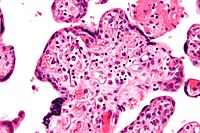
Photo from wikipedia
Background Fetuses affected by placental insufficiency do not receive adequate nutrients and oxygenation, become growth restricted and acidemic, and can demise. Preterm fetal growth restriction is a severe form of… Click to show full abstract
Background Fetuses affected by placental insufficiency do not receive adequate nutrients and oxygenation, become growth restricted and acidemic, and can demise. Preterm fetal growth restriction is a severe form of placental insufficiency with a high risk of stillbirth. We set out to identify maternal circulating mRNA transcripts that are differentially expressed in preterm pregnancies complicated by very severe placental insufficiency, in utero fetal acidemia, and are at very high risk of stillbirth. Methods We performed a cohort study across six hospitals in Australia and New Zealand, prospectively collecting blood from 128 pregnancies complicated by preterm fetal growth restriction (delivery < 34 weeks’ gestation) and 42 controls. RNA-sequencing was done on all samples to discover circulating mRNAs associated with preterm fetal growth restriction and fetal acidemia in utero. We used RT-PCR to validate the associations between five lead candidate biomarkers of placental insufficiency in an independent cohort from Europe (46 with preterm fetal growth restriction) and in a third cohort of pregnancies ending in stillbirth. Results In the Australia and New Zealand cohort, we identified five mRNAs that were highly differentially expressed among pregnancies with preterm fetal growth restriction: NR4A2 , EMP1 , PGM5 , SKIL , and UGT2B1 . Combining three yielded an area under the receiver operative curve (AUC) of 0.95. Circulating NR4A2 and RCBTB2 in the maternal blood were dysregulated in the presence of fetal acidemia in utero. We validated the association between preterm fetal growth restriction and circulating EMP1 , NR4A2 , and PGM5 mRNA in a cohort from Europe. Combining EMP1 and PGM5 identified fetal growth restriction with an AUC of 0.92. Several of these genes were differentially expressed in the presence of ultrasound parameters that reflect placental insufficiency. Circulating NR4A2 , EMP1 , and RCBTB2 mRNA were differentially regulated in another cohort destined for stillbirth, compared to ongoing pregnancies. EMP1 mRNA appeared to have the most consistent association with placental insufficiency in all cohorts. Conclusions Measuring circulating mRNA offers potential as a test to identify pregnancies with severe placental insufficiency and at very high risk of stillbirth. Circulating mRNA EMP1 may be promising as a biomarker of severe placental insufficiency.
Journal Title: BMC Medicine
Year Published: 2020
Link to full text (if available)
Share on Social Media: Sign Up to like & get
recommendations!